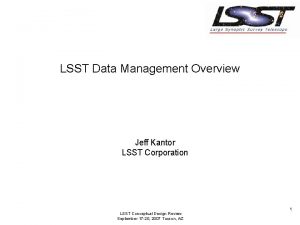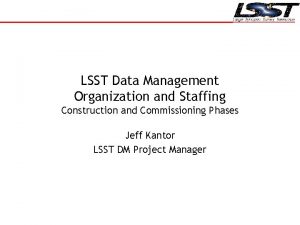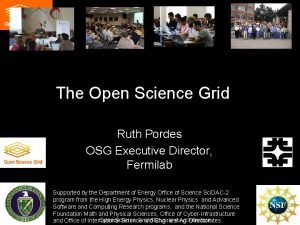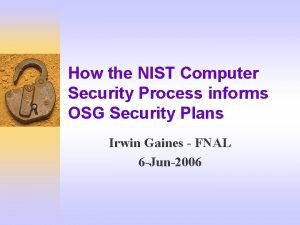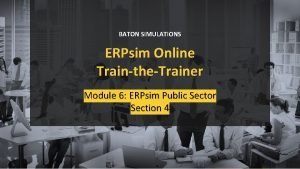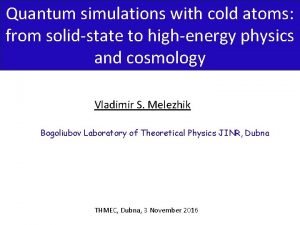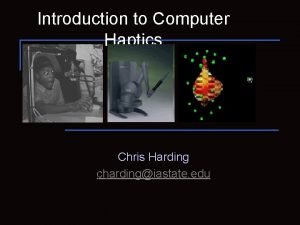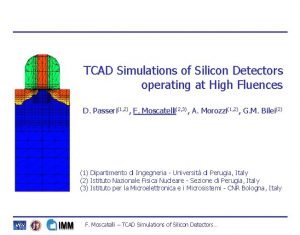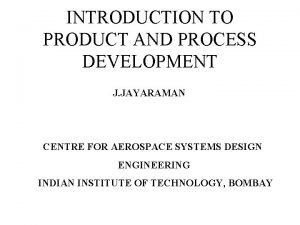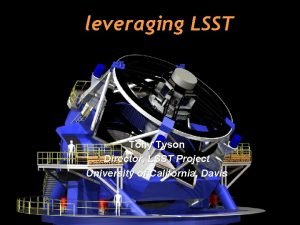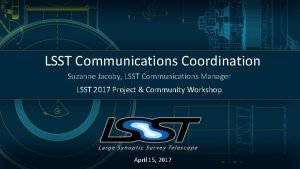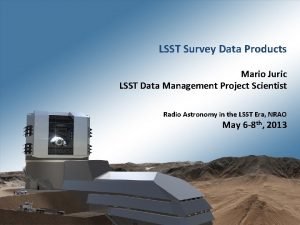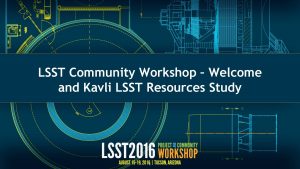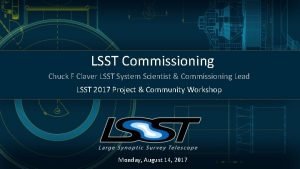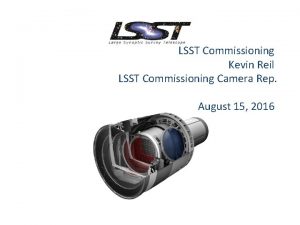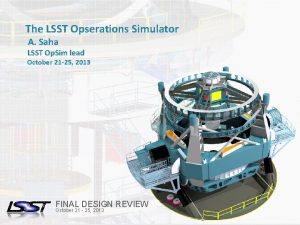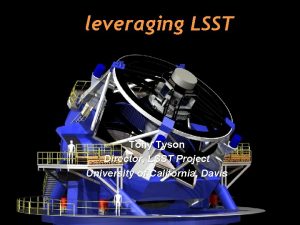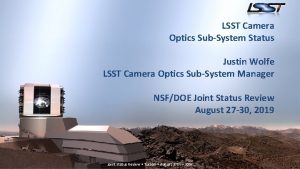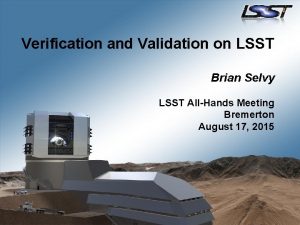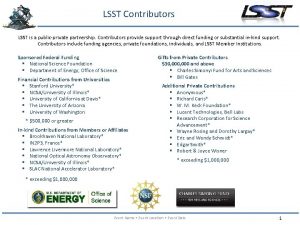LSST Simulations on OSG Overview OSG Engagement of














- Slides: 14

LSST Simulations on OSG Overview • • • OSG Engagement of LSST Simulation Workflow Requirements System Architecture Resource Utilization Operational Experience Results Validation September 22, 2010 Parag Mhashilkar, Gabriele Garzoglio for the OSG Task Force on LSST Computing Division, Fermilab Sep 22, 2010 1/14

LSST Simulations on OSG Introduction • LSST at Purdue (Ian Shipsey) and OSG are collaborating to explore the use of the OSG to run LSST computations • Integrated the current LSST image simulation with OSG • In September, Bo Xin (LSST Purdue) has… – produced 150 image pairs and is working on 350 more – validated the OSG production against one official reference (PT 1) image Sep 22, 2010 2/14

LSST Simulations on OSG “engagement” of LSST • Goal of the effort: OSG to empower LSST to use OSG resources independently • Engagement phase: OSG provides experts for a limited time to help with – commissioning a submission system (software & resources) to run LSST workflows on OSG resources – supporting the integration of LSST applications with OSG – supporting the initial LSST operations Sep 22, 2010 3/14

LSST Simulations on OSG History • Feb 2010 – Proof of principle of 1 LSST image simulated on OSG • Jun 2010 – OSG EB forms an OSG task force for LSST – Goal of the project is to simulate one night of image taking (500 image pairs) • Jul 2010 – Commissioning of the LSST submission system on OSG – Using an old application release (svn-11853), 1 person produced 183 times the same image in 1 day • Aug 2010 – Integrated “current” LSST release (svn-16264) with the system • Sep 2010 – LSST operator (Bo Xin) ran operations to produce 529 pairs. Sep 22, 2010 4/14

LSST Simulations on OSG Workflow Requirements • LSST simulation of 1 image: 189 trivially parallel jobs for the 189 chips • Input to the workflow: – SED catalog files: 15 GB uncompressed, pre-installed at all sites – Catalog files (SED files + wind speed, etc. ): 500 MB compressed per image pair • Workflow: – Trim catalog file into 189 chip-specific files – Submit 2 x 189 jobs: 1 image pair (same image w/ 2 exposures) • Output: 2 x 189 FITS files, 10 MB each compressed Sep 22, 2010 5/14

LSST Simulations on OSG Production by Numbers • Goal: simulate 1 night of LSST data collection: 500 pairs • 200 k simulation jobs (1 chip at a time) + 500 trim jobs • Assume 4 hours / job for trim and simulation (over-est. ) 800, 000 CPU hours • Assume 2000 jobs DC ~50, 000 CPU hours / day • • • 17 days to complete (w/o counting failures) 12, 000 jobs / day i. e. 31 image pairs / day 50 GB / day of input files moved (different for every job) 300 GB / day of output Total number of files = 400, 000 (50% input - 50% output) Total output compressed = 5. 0 TB (25 MB per job) Sep 22, 2010 6/14

LSST Simulations on OSG Architecture Submit 2 Monitor 5 Glidein VO Frontend User Interface Submitter 3 Create DAG Submit Local Disk Condor Collector 1 3 1 WN Info Condor Scheduler Hadoop OSG Glidein Factory CE 4 Glidein Grid Site Job & Data Binaries and SED files pre-installed via OSG MM Sep 22, 2010 7/14

LSST Simulations on OSG Operations • Current setup: Central machine hosts • glidein. WMS VO Frontend • User Pool (collector), Condor Scheduler • Unmanaged dedicated storage • If LSST became a stand-alone VO • it could benefit from managed public storage • upload input data to OSG and download output data from OSG public storage • data maintenance could be done through metadata (e. g. remove trim and catalog input files for all workflow that have an output) • data processing would not depend on the availability of a single resource Sep 22, 2010 8/14

LSST Simulations on OSG Monitoring Operations • • If job exits due to system failure automatically resubmit indefinitely If job exits due to app. failure resubmit 5 times Periodically look at the output dir … Sep 22, 2010 9/14

LSST Simulations on OSG Resource Utilization • • By September 3, produced 150 pairs in 5 days using 13 sites. Now 400 / 529 pairs are produced (some chips job may require recovery) 150 pairs produced Gratia Resource Utilization plots Sep 22, 2010 Frontend Status: Jobs & Glideins 10/14

LSST Simulations on OSG Typical Workflow Statistics Sep 22, 2010 11/14

LSST Simulations on OSG Operational Challenges • LSST binaries were not Grid-ready – Application assumed writable software distribution – Application assumed path-lengths too short for the Grid – Orchestration script did not exit with failure upon error (required manual recovery until fixed) • Typical failures at sites: – Job required more memory than the batch system allotted – Storage unavailable due to maintenance at some of the most productive sites • Limited disk quota on the submission machine • After the production of 150 pairs, the operator was mostly traveling and had limited time to dedicate to the operations Sep 22, 2010 12/14

LSST Simulations on OSG Validation: comparison with PT 1 • Validation Mechanism: – Subtract an image pixel by pixel from a reference image. – Produced 2 different images twice on OSG, each on a different mix of resources. • – In both cases, the pixel-subtraction is consistently 0. We compared 1 image pair (378 chips) with an “official” reference (PT 1). • For 374 chips the pixel -subtraction is consistently 0. • For 4 chips it is negligible*. More investigations are under way. Study done by Bo Xin. Sep 22, 2010 13/14

LSST Simulations on OSG Conclusions • This project has demonstrated that OSG is a valuable platform to simulate LSST images • 1 LSST person, Bo Xin, with expert support has produced 150 image pairs in 5 days, using in average 50, 000 CPU h / day. • Bo is currently finishing the production of 529 pairs (400 done with possible needs for recovery) • Image simulation is the first application integrated with OSG. The integration of data-intensive applications might follow • If LSST became a stand-alone VO, it could benefit from managed public storage supported by OSG • Thank you to the OSG Task Force – Especially to Brian Bockelman and Derek Weitzel Sep 22, 2010 14/14
 Lsst corporation
Lsst corporation Lsst
Lsst Lsst
Lsst Lsst
Lsst Osg architecture
Osg architecture Osg walk in
Osg walk in Yes or no
Yes or no World history simulations
World history simulations Baton simulations
Baton simulations Clinical simulations in nursing education
Clinical simulations in nursing education Simulations for solid state physics
Simulations for solid state physics Chris harding simulations
Chris harding simulations Www.irs.gov/app/understanding taxes/student/simulations.jsp
Www.irs.gov/app/understanding taxes/student/simulations.jsp Tcad simulations
Tcad simulations Pinpoint simulations 777
Pinpoint simulations 777
